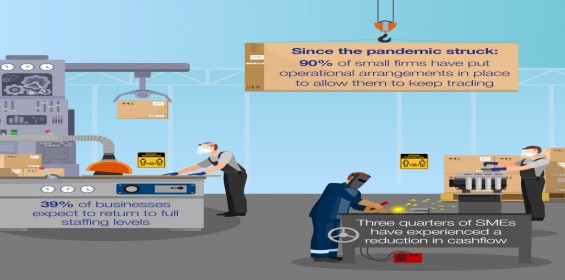SMEs unclear when C-19 special operational arrangements will end
Published: 19 August, 2020
The Covid-19 pandemic is continuing to have far-reaching impacts for the UK’s SME community, with at least three quarters experiencing a reduction in their cashflow, while a further 90% have had to put in place operational arrangements to allow them to keep trading, according to the latest independent research from Close Brothers Asset Finance*.
Those additional operational arrangements include working from home, staggered start times, alternate work days and enforced social distancing.
“SMEs are struggling to predict just how long the impacts of the pandemic will be felt,” said Neil Davies, CEO, Close Brothers Asset Finance and Leasing. “But what’s clear is firms are – in the face of cashflow pressures – getting on with the job and doing what needs to be done to get back up and trading.
“Many are making use of government assistance, with around half of those surveyed saying they’ve made use of the furlough scheme, while a further 31% have already applied for a CBILS (Coronavirus Business Interruption Loan Scheme) loan; interestingly, 52% said that while they knew about it, they didn’t feel it was currently required. A further 16% were on the fence about whether to apply.”
Operational impact
Four in 10 firms have stated they’re ‘open as normal’ – contrasted against this figure is the 21% who are closed completely until lockdown ends. A further fifth’s workers are now home-based and 9% available for online consultations or meetings.
“With numerous businesses able to operate from home, this, for many, has become the ‘new normal’, which likely explains why so many are ‘open as normal’,” said Neil. “We’ve seen this with our own business – despite the initial challenges, we’ve been able to continue to serve the needs of our customers, both existing and new.”
Nearly all participating businesses expect operational arrangements to be in place for at least a few months, with 6% planning for the measures to be made permanent:
Less than 1 month 4%
1-3 months 21%
4-6 months 31%
7-9 months 13%
10-12 months 10%
Longer than 12 months 9%
We expect the measures put in place to become permanent 6%
Don’t know 6%
There are mixed views; however, about when firms expect to be fully operational again, with two thirds of the opinion it will be anything between three to six months.
“These figures underline the uncertainty business owners and employees alike are operating under,” said Neil. “And this is reflected in their predictions about future staffing levels – 39% will be returning with the same number and 9% are anticipating hiring more staff.
“On the more conservative side of the coin, 44% are planning to return with fewer people.”
The full results of the latest results are available for download on the free-to-use SME Data Hub.
*All figures, unless otherwise stated, are from a Kantar survey conducted in July 2020. The survey canvassed the opinion of over 900 SME owners across the UK and Ireland and across several industries on a range of issues affecting their businesses.
For more news from Close Brothers Asset Finance, please click here.







